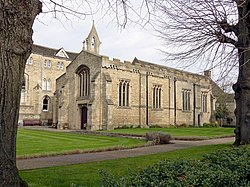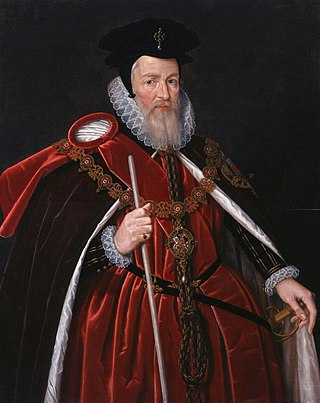
William Cecil, 1st Baron Burghley was an English statesman, the chief adviser of Queen Elizabeth I for most of her reign, twice Secretary of State and Lord High Treasurer from 1572. In his description in the Encyclopædia Britannica Eleventh Edition, A.F. Pollard wrote, "From 1558 for forty years the biography of Cecil is almost indistinguishable from that of Elizabeth and from the history of England."
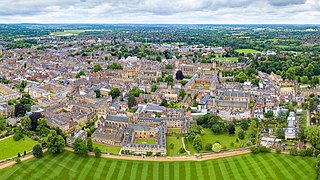
The ancient universities are British and Irish medieval universities and early modern universities founded before the year 1600. Four of these are located in Scotland, two in England, and one in Ireland. The ancient universities in Britain and Ireland are amongst the oldest extant universities in the world. The ancient universities in Britain are part of twenty-seven culturally significant institutions recognised by the British monarchy as privileged bodies of the United Kingdom.

Stamford is a town and civil parish in the South Kesteven district of Lincolnshire, England. The population at the 2011 census was 19,701 and estimated at 20,645 in 2019. The town has 17th- and 18th-century stone buildings, older timber-framed buildings and five medieval parish churches. It is a frequent film location. In 2013 it was rated a top place to live in a survey by The Sunday Times. Its name has been passed on to Stamford, Connecticut, founded in 1641.

Marquess of Exeter is a title that has been created twice, once in the peerage of England and once in the peerage of the United Kingdom. The first creation came in the peerage of England in 1525 for Henry Courtenay, 2nd Earl of Devon. For more information on this creation, which was forfeited in 1538, see Earl of Devon.
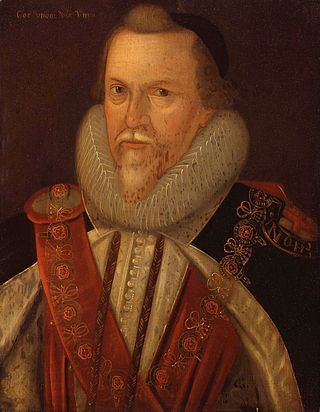
Thomas Cecil, 1st Earl of Exeter, KG, known as Lord Burghley from 1598 to 1605, was an English politician, courtier and soldier.

David George Brownlow Cecil, 6th Marquess of Exeter, KCMG KStJ, styled Lord Burghley before 1956 and also known as David Burghley, was an English athlete, sports official, peer, and Conservative Party politician. He won the gold medal in the 400 m hurdles at the 1928 Summer Olympics.
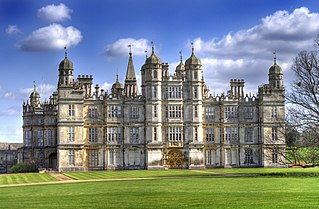
Burghley House is a grand sixteenth-century English country house near Stamford, Lincolnshire. It is a leading example of the Elizabethan prodigy house, built and still lived in by the Cecil family and is Grade I listed.
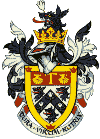
Sedbergh School is a public school in the town of Sedbergh in Cumbria, North West England. It comprises a junior school for pupils aged 4 to 13 and the main school for 13 to 18 year olds. It was established in 1525.

William Alleyne Cecil, 3rd Marquess of Exeter PC, styled Lord Burghley between 1825 and 1867, was a British peer and Conservative politician. He served as Treasurer of the Household between 1866 and 1867 and as Captain of the Honourable Corps of Gentlemen-at-Arms between 1867 and 1868.
Francis Peck (1692–1743) was an English priest of the Church of England and antiquary, best known for his Desiderata Curiosa (1732–1735).
Lincolnshire is one of the few counties within the UK that still uses the eleven-plus to decide who may attend grammar school, in common with Buckinghamshire and Kent.
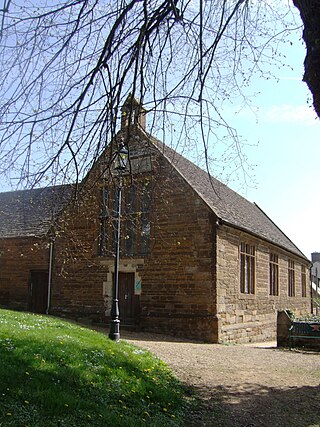
Robert Johnson was a Church of England cleric and the founder of both Oakham School and Uppingham School.
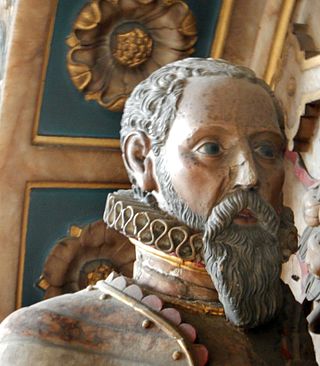
Sir Richard Cecil was an English nobleman, politician, courtier, and Master of Burghley (Burleigh) in the parish of Stamford Baron, Northamptonshire. His father Sir David Cecil, of Welsh ancestry, rose in favour under King Henry VIII of England, becoming High Sheriff of Northamptonshire in 1532 and 1533, and died in 1541.

John Cecil, 5th Earl of Exeter, known as Lord Burghley until 1678, was a British peer and Member of Parliament. He was also known as the Travelling Earl.

Willem Wissing, known in England as William Wissing, was a Dutch portrait artist who worked in England.
Stamford High School was an independent school for girls in Stamford, Lincolnshire, England, situated on High Street, St Martin's. From September 2023, it merged with Stamford School to become fully co-educational.
Bridgnorth Endowed School is a coeducational secondary school with academy status, located in the market town of Bridgnorth in the rural county of Shropshire, England. Founded in 1503, The Endowed School is a state school and is a specialist Technology College. The age range of the school is 11–18 years. It was previously known as the Bridgnorth Grammar School, and the school celebrated the 500th anniversary of its foundation in 2003. Former pupils include Professor Peter Bullock, the inspirational soil scientist who was a member of the Intergovernmental Panel on Climate Change (IPCC).

The Church of St Paul in Stamford, Lincolnshire, England, was one of the town's fourteen Medieval parish churches until its deconsecration and extensive demolition during the Reformation when the remaining part became used as the schoolroom of Stamford School. It was then restored and extended in 1929-30 for use as the school chapel in commemoration of those old boys and staff who had died in the First World War. The medieval remains were the eastern part of the south aisle and adjacent fragments of the nave of the church.
The history of Brasenose College, Oxford, stretches back to 1509, when Brasenose College was founded on the site of Brasenose Hall. Its name is believed to derive from the name of a bronze knocker that adorned the hall's door. The college was associated with Lancashire and Cheshire, the county origins of its two founders – Sir Richard Sutton and the Bishop of Lincoln, William Smyth – a link that was maintained strongly until the latter half of the nineteenth century. The first principals navigated Brasenose, with its Catholic sympathisers, through the reformation and continuing religious reforms. Most of Brasenose favoured the Royalist side during the English Civil War, although it produced notable generals and clergy on both sides. The library and chapel were completed in the mid-seventeenth century, despite Brasenose suffering continuing financial problems.

The University of Stamford was an academic institution founded in 1333 in Stamford, Lincolnshire, by a group of students and tutors from the University of Oxford, including Merton College and Brasenose Hall.
